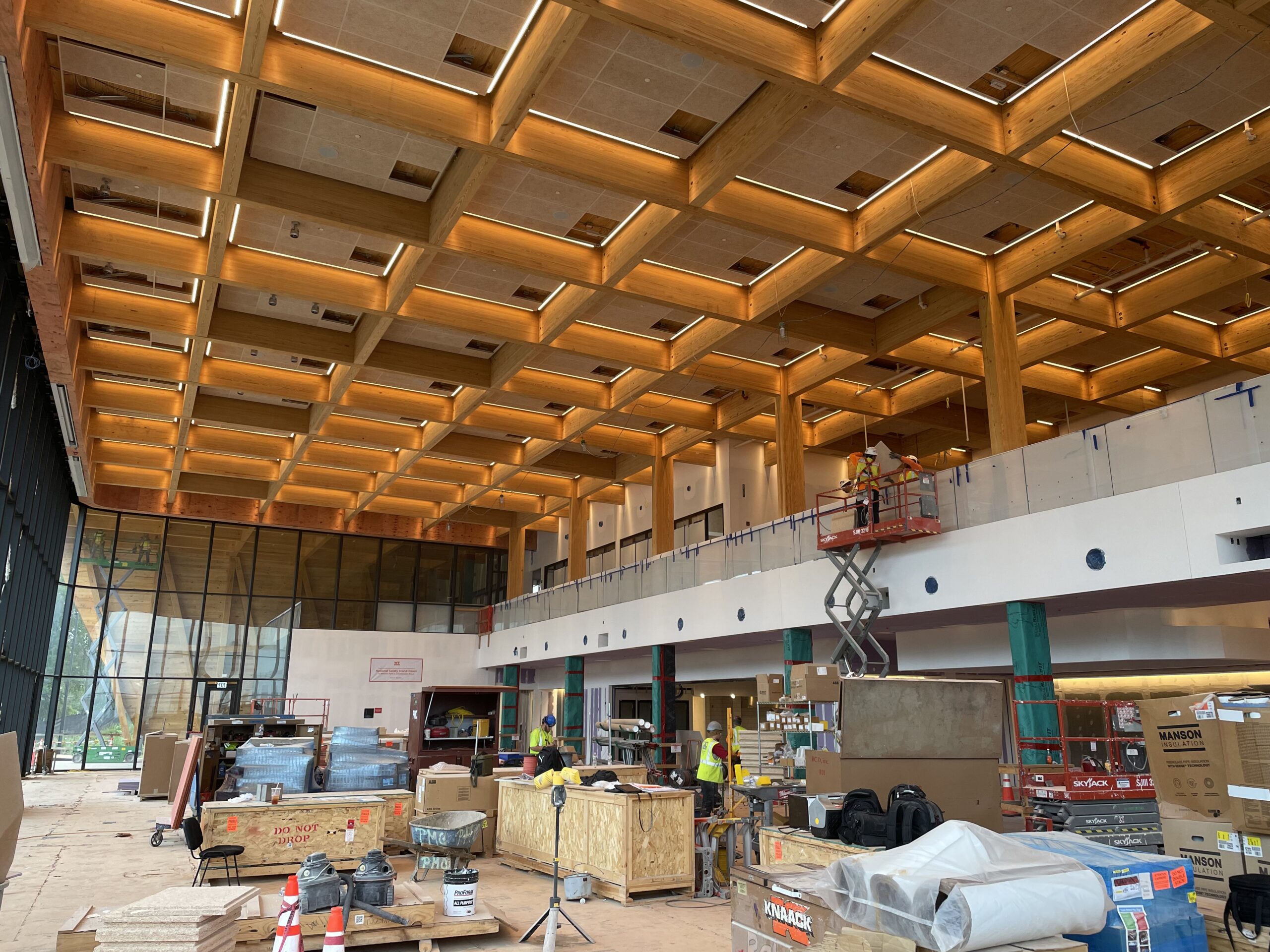
Mass Timber vs. Traditional Construction: Pros and Cons
Choosing the right structural system sets the tone for cost, schedule, and the experience you deliver. This side-by-side look at mass timber vs. traditional construction explains where each shines and how to compare options fairly for your building type, site, and goals. We’ll cover structural systems and components, fire and code considerations, schedule and cost drivers, and the environmental benefits and tradeoffs owners and project teams should weigh.
What Makes Mass Timber Different
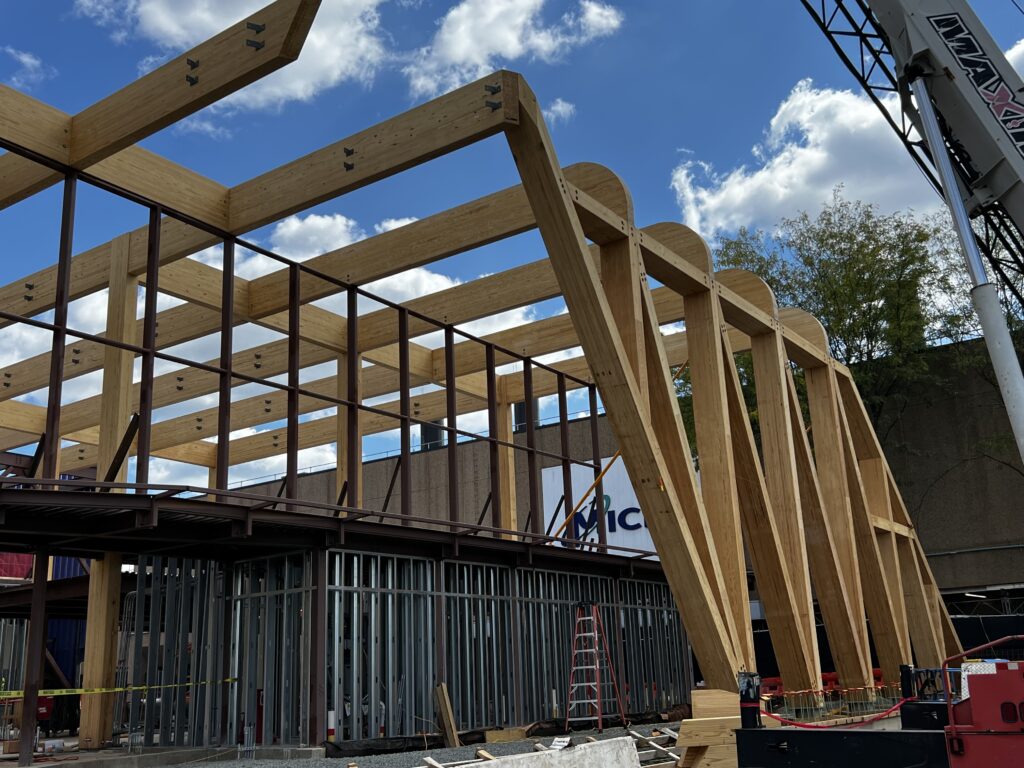
Mass timber construction uses engineered wood products as primary structural elements. These include cross laminated timber (CLT), glue laminated timber (glulam), laminated veneer lumber (LVL), nail laminated timber (NLT), and dowel laminated timber (DLT). These larger, prefabricated mass timber components arrive as slabs, walls, and beams/columns that fit together with shop-drawn precision. In many mass timber buildings, panels double as structure and finish, so the construction process can be faster and cleaner than conventional wet trades.
Architecturally, exposed engineered wood offers warmth and biophilic appeal. Leaving mass timber elements visible (ceilings, beams, columns) can reduce applied finishes and create a distinct interior character that’s hard to replicate with traditional building materials. For owners seeking memorable spaces, this is a real advantage.
Pros of Mass Timber
Schedule and Site Advantages
Prefabricated mass timber panels and larger elements can compress on-site duration. Lighter lifts and fewer deliveries ease congestion on a tight construction site. When shop drawings are coordinated early, the erection sequence becomes straightforward, which can improve labor costs and reduce rework.
Environmental Benefits
Wood construction stores carbon. Compared to concrete and steel, many mass timber products have a lower carbon footprint due to carbon storage in wood fiber and the potential for responsible forest management. For owners pursuing environmental benefits, mass timber offers a credible pathway.
Structural Performance and Weight
Timber’s high strength-to-weight ratio helps with seismic resilience and foundation sizes. The lateral force resisting system can be designed with CLT shear walls, braced frames, or hybrid cores, depending on building codes and performance targets. Light weight also helps with additions over existing structures where capacity is limited.
Design and Occupant Experience
Exposed wood interiors deliver architectural appeal without covering structure in gypsum wallboard. Mass timber structures can achieve long spans with glulam beams and CLT slabs, creating open plans well suited to collaborative workplaces and residential projects with shared amenities.
Cons of Mass Timber
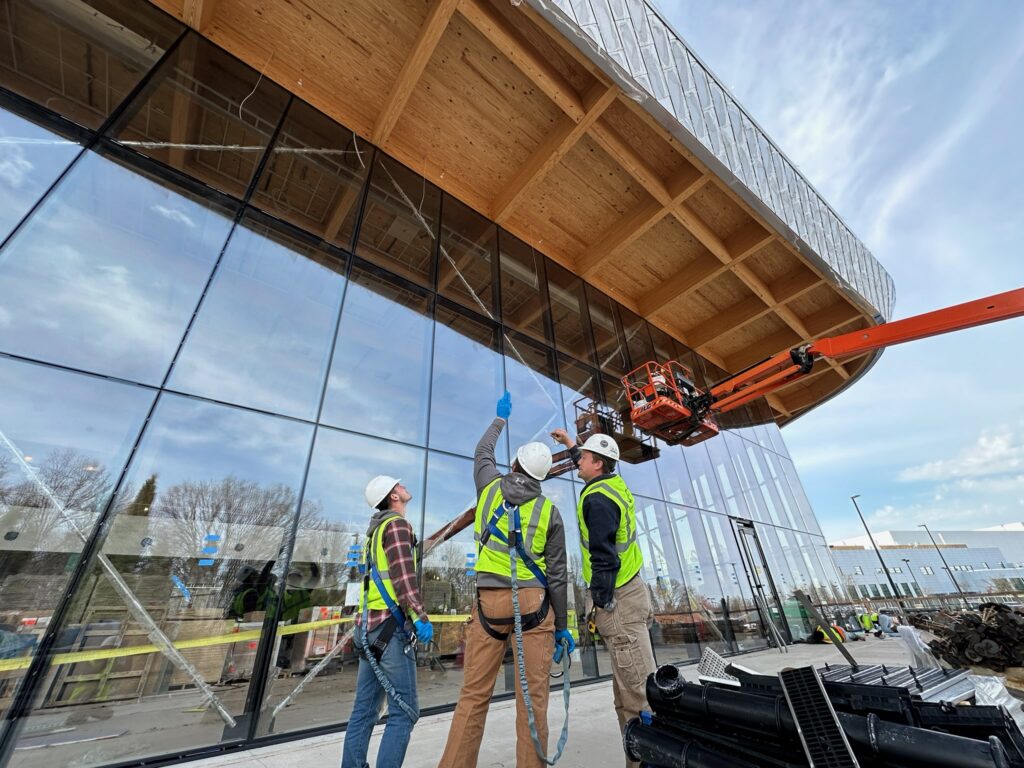
Fire Protection and Detailing
Mass timber is fire resistant by charring, but assemblies must be carefully detailed and, in many cases, encapsulated with rated layers to meet code. Fire protection strategies depend on construction type, building height/area, and occupancy. Tested details and disciplined coordination around penetrations are non-negotiable.
Acoustics and MEP Coordination
Meeting acoustic targets (particularly impact noise between dwelling units) requires floor toppings, mats, or suspended ceilings. Mechanical/electrical/plumbing penetrations through mass timber panels must be pre-planned to avoid costly field modifications.
Supply Chain and Cost Variability
Mass timber production capacity and transportation distances influence construction costs and schedule. Availability can vary by region (e.g., western United States and British Columbia have more manufacturing), so procurement timing and logistics planning are critical to remain cost competitive.
Limitations by Building Type
Taller mass timber buildings are increasingly permitted, but some programs are still typically limited by local adoption of newer codes. Parking decks, long-span industrial spaces, or heavy rooftop loads often favor steel or concrete, or hybridize mass timber with conventional cores and podiums.
Pros of Traditional Construction
Capacity, Spans, and Familiarity
Steel or concrete frames excel at very long spans, heavy point loads, and complex geometry. The construction industry has deep familiarity with these systems, a wide supply network, and established trade sequencing, advantages that can simplify procurement and staffing.
Fire and Code Pathways
Traditional steel and concrete solutions come with well-documented fire resistant assemblies and jurisdictional comfort. Approvals for common building types may be more predictable, which can help keep the project schedule on track.
Predictable Price Signals
In some markets, competition and supply depth make concrete and steel cost effective. Contractors understand the risk profile, and estimating norms are mature, which can reduce uncertainty.
Cons of Traditional Construction
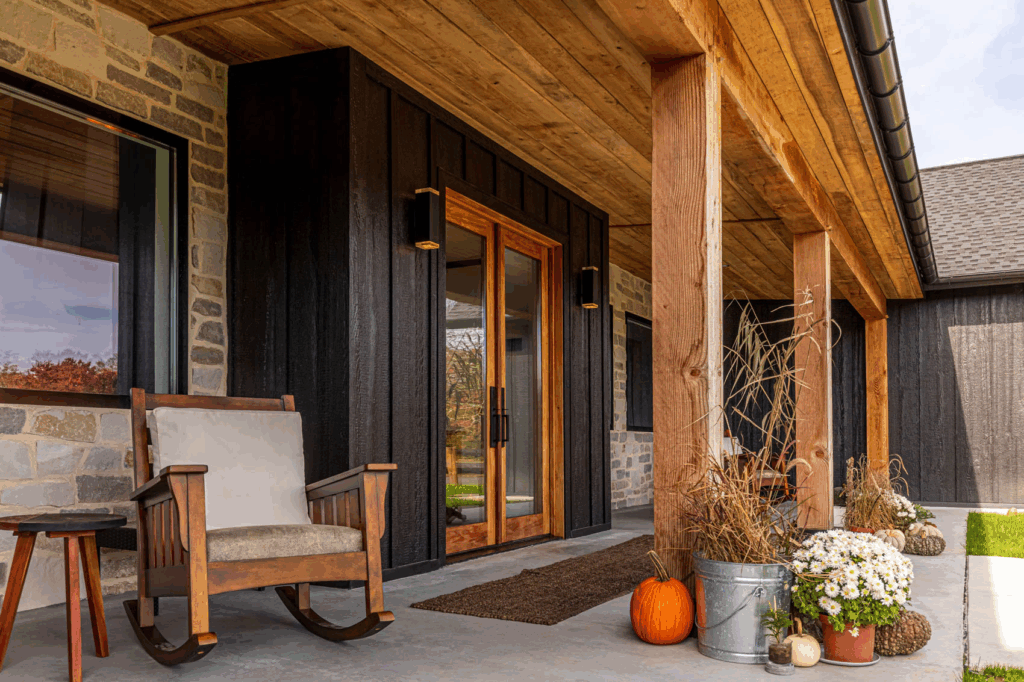
Environmental Impacts
Concrete and steel typically carry higher embodied carbon and drive more carbon emissions compared with mass timber. There are mitigation strategies, but owners targeting a lower carbon footprint must plan deliberately.
Site and Schedule Impacts
Heavier materials, more deliveries, and wet trades can extend durations, especially where curing or staging space is constrained. Waste management and weather exposure can add friction on tight urban sites.
Codes, Fire Performance, and Compliance
Building codes are evolving to allow taller mass timber buildings under specific construction types with defined height/area limits. The essentials:
- Fire performance: Mass timber uses charring and/or encapsulation; concrete and steel use rated assemblies and fireproofing. Both approaches rely on tested details and inspection.
- Interface details: Exterior walls, shafts, and penetrations must maintain ratings and continuity. Gypsum wallboard, mineral wool, and sealants are typical tools across systems.
- Approval pathway: Clear documentation keeps reviews moving. Early dialogue with authorities having jurisdiction reduces surprises.
Cost, Schedule, and Risk: What Really Drives Outcomes
- Design coordination: Early, accurate coordination (panel grids, connection details, MEP routes) is the single biggest lever for mass timber. For concrete/steel, rebar/shop drawing clarity and formwork/sequence logic drive efficiency.
- Finish strategy: If mass timber is exposed, you may save on finishes but invest more in protection and tolerances. Concealed systems level the field.
- Procurement: Lead times for mass timber panels and glulam, or for steel bar joists and switchgear, can set the critical path. Lock procurement plans early.
- Labor market: Local crew experience affects productivity and bids.
When Each System Shines
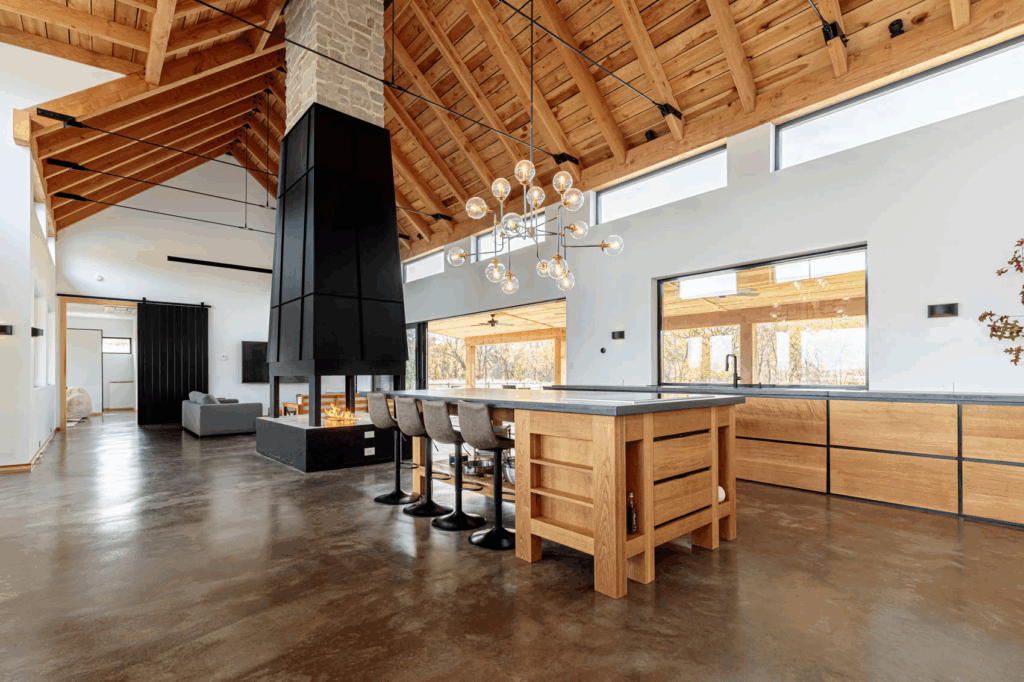
Mass Timber Sweet Spots
Mid-rise offices, community buildings, and multifamily where a warm interior and fast erection matter; additions over existing structures; sites where lighter weight reduces foundations; projects prioritizing lower embodied carbon and a distinctive occupant experience.
Traditional Construction Sweet Spots
Very long spans, heavy industrial loads, below-grade and podium levels, parking, or building types where mature detailing and broad subcontractor capacity reduce risk. Hybrids are common: steel or concrete cores and stairs with mass timber floors and beams above.
Decision Framework for Project Teams
Start with goals, not assumptions. If sustainability and architectural appeal are priorities, mass timber offers a strong case. If spans, parking, or complex cores dominate, concrete and steel may lead, with opportunities to incorporate wood where it makes sense. The best outcomes often come from hybrids that place the right material in the right location, such as mass timber floors over a concrete podium, or glulam frames with a steel lateral system.
Practical next steps to compare options well:
- Define building type, construction type, and target height/area early.
- Ask for parallel concepts: mass timber structures vs. concrete and steel baselines with equal performance targets.
- Align fire protection strategies and acoustic targets before pricing.
- Confirm supply chain and lead times for mass timber products and conventional materials in your region.
The Bottom Line
There is no universal winner. Only the right fit for your goals and site. Mass timber buildings deliver speed, architectural appeal, and meaningful environmental benefits when coordination and procurement are handled early. Concrete and steel remain powerful, proven systems for long spans, complex programs, and jurisdictions favoring familiar assemblies.
Evaluate mass timber vs traditional construction with equal assumptions, disciplined documentation, and a clear view of codes, cost, and schedule. That’s how project teams move from concept to a building that performs.

